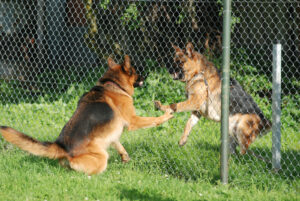Barks Blog
Compulsivity and the Dog

Since humans are unable to ascertain the aspect of a disorder in an animal that deals with obsessing, animals are not generally given the diagnosis of OCD. However, it is completely possible that a pet can have a compulsive disorder.
Compulsive behaviors include behaviors that are induced by conflict or frustration, behaviors that are displaced (displayed at inappropriate times), redirected behavior (acted out on a different target), vacuum activity (self-directed), and stereotypies (Landsberg, Hunthausen, and Ackerman, 1997). Abnormal behaviors often stem from an animal’s inability to adequately cope within its environment. Compulsivity in dogs is often expressed with behaviors such as tail chasing, flank sucking (often seen in Dobermans), fence running, fly/hair/air snapping, self-mutilation (such as acral lick dermatitis), pica, pacing, spinning, staring with vocalization or self-directed vocalization, chewing or sucking fabric, and even some aggressive behaviors (Overall and Dunham, 2002). Landsberg, Hunthausen, and Ackerman (1997) suggest that these behaviors stem from insufficient stimulation, lack of routine, inconsistent training techniques, anxiety-related situations, changes in the home or the family, conflict, and frustration. Both the physical environment and the emotional/familial environment have an impact on the dog and his resulting behavior.
Yeruham and Nyska (1998) studied a captive jackal that was treated topically for acral lick dermatitis (ALD), a compulsive condition. Though the physical condition was treated medicinally, the behavioral aspect of the ALD resolved when the jackal was moved to another pen containing two other young jackals. Being moved from a solitary living situation into a more social environment was key to resolving this canid’s condition. This particular behavioral condition is known to release endorphins, thus providing a reinforcement for the unwanted behavior (White, 1990 as cited by Yeruham and Nyska, 1998). This is just one example of how the animal’s environment can impact behavior in such a way that compulsions surface. Of course, by allowing such behaviors to take hold, reinforcement can occur naturally, as one can see in this example. However, there are other ways in which an owner can unintentionally reinforce compulsive behavior.
One such way of reinforcing compulsive behavior is to provide an animal with negative reinforcement (Landsberg, Hunthausen, and Ackerman, 1997). In this situation the owner may withdraw the stimulus that is causing the anxiety. One example would be the dog that reacts to a stressful situation with redirected behavior. The UPS truck can generate anxiety within the dog, who anticipates a ring of the doorbell and someone on the front stoop. When the UPS driver leaves a package on the step, “Jake” will attack that package – redirecting his anxiety toward the package rather than the driver. This behavior can then generalize to all packages/cardboard boxes. In this example, Jake may receive reinforcement from his owner removing the source of anxiety, the package. Once the package is gone, his anxiety will dissipate, thus reinforcing his behavior.
Another type of reinforcement of compulsive behavior occurs when an owner provides positive reinforcement, unwittingly. For example, if the owner provides a treat to entice little Rocky away from flank sucking, the treat may serve to reinforce his flank sucking. In other words, Rocky may begin to suck on his flanks in order to obtain the treat.
Landsberg, Hunthausen, and Ackerman (1997) also point out that an owner who reacts to a dog’s compulsive behavior with punishment, which can also serve to reinforce the behavior. This happens because in providing punishment the owner is in fact giving the animal attention for the behavior. In this case, or in the case where the behavior generalizes (as in the above example with Jake), the behavior can occur in situations where there is actually no known anxiety or conflict (Landsberg, et al., 1997).
Knowing the source of environmental triggers can provide the animal professional and owner a wealth of ammunition in addressing compulsive behaviors:
How many hours per day is the animal left alone?
Where does the animal stay during these times?
What items does the animal have access to during his alone times?
Have there been any recent changes in the home or family?
These and other questions will help the behaviorist to pinpoint the etiology of the behavior and its reinforcers.
References:
Landsberg, G., Hunthausen, W., and Ackerman, L. (1997). Handbook of Behavior Problems of the Dog and Cat. Elsevier.
Overall, K. and Dunham, A. (2002). Clinical features and outcome in dogs and cats with obsessive-compulsive disorder: 126 cases (1989-2000). JAVMA, 221 (10), 1445-1452.
Yeruham, I. and Nyska, A. (1998). Acral Lick Dermatitis in a Jackal (Canis aureus). Journal of Zoo and Wildlife Medicine. 29 (2) 233.
